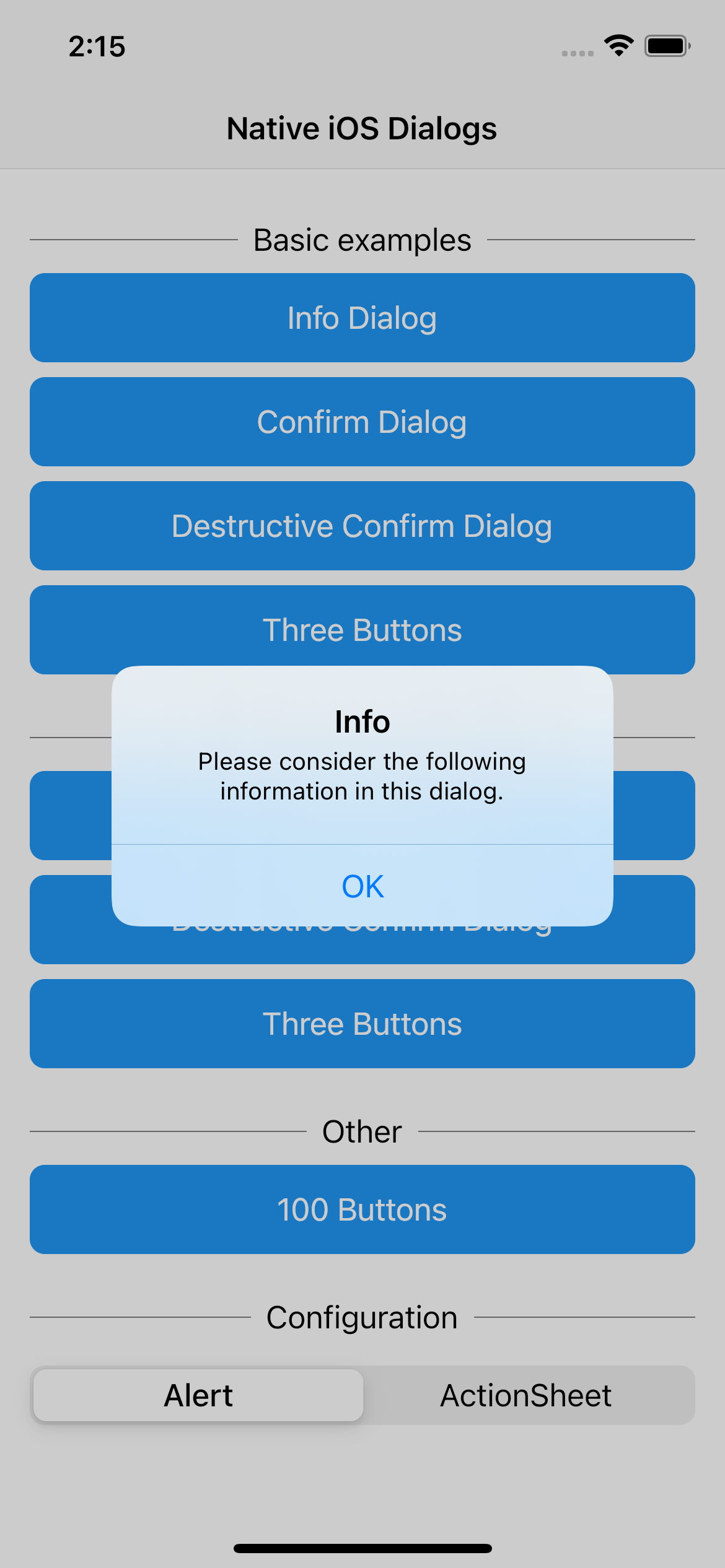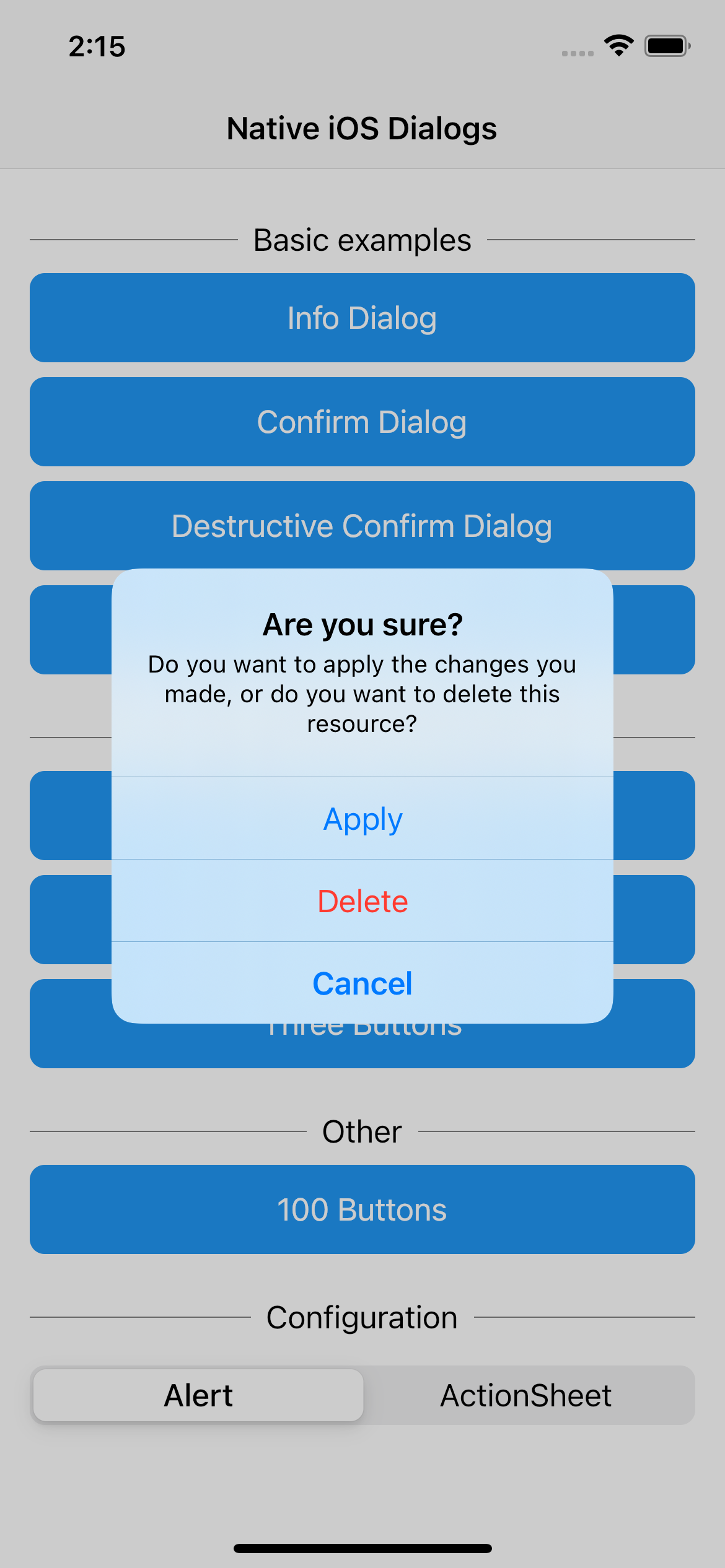Flutter原生iOS对话框插件native_ios_dialog的使用
Flutter原生iOS对话框插件native_ios_dialog的使用
Native iOS Dialog
native_ios_dialog 是一个Flutter插件,它使显示与iOS原生等效的 CupertinoAlertDialog 或 CupertinoActionSheet 对话框变得简单。
Usage
要使用此插件,请将 native_ios_dialog 添加为依赖项到你的 pubspec.yaml 文件中。Flutter中的对话框功能非常强大,但是 CupertinoAlertDialogs 并不能完全提供与原生iOS对话框相同的感觉,因此创建了这个插件。通过该插件,你可以拥有iOS提供的所有自定义选项。
Types of dialogs
- Alert
- Action Sheet


Types of buttons
- Default
- Destructive
- Cancel
每个按钮也可以被禁用。



Sample Usage
Info dialog
NativeIosDialog(
title: "Info",
message: "Please consider the following information in this dialog.",
style: style,
actions: [
NativeIosDialogAction(
text: "OK",
style: NativeIosDialogActionStyle.defaultStyle,
onPressed: () {},
),
],
).show();
Confirm dialog
NativeIosDialog(
title: "Confirm",
message: "Please confirm the following information in this dialog.",
style: style,
actions: [
NativeIosDialogAction(
text: "OK",
style: NativeIosDialogActionStyle.defaultStyle,
onPressed: () {},
),
NativeIosDialogAction(
text: "Cancel",
style: NativeIosDialogActionStyle.cancel,
onPressed: () {},
),
],
).show();
完整示例代码
import 'package:flutter/cupertino.dart';
import 'package:flutter/material.dart';
import 'package:native_ios_dialog/native_ios_dialog.dart';
void main() {
runApp(const MyApp());
}
class MyApp extends StatelessWidget {
const MyApp({Key? key}) : super(key: key);
@override
Widget build(BuildContext context) {
return const CupertinoApp(
debugShowCheckedModeBanner: false,
home: HomePage(),
);
}
}
class HomePage extends StatefulWidget {
const HomePage({Key? key}) : super(key: key);
@override
_HomePageState createState() => _HomePageState();
}
class _HomePageState extends State<HomePage> {
int currentDialogStyle = 0;
@override
Widget build(BuildContext context) {
final NativeIosDialogStyle style = currentDialogStyle == 0
? NativeIosDialogStyle.alert
: NativeIosDialogStyle.actionSheet;
return CupertinoPageScaffold(
navigationBar: const CupertinoNavigationBar(
middle: Text("Native iOS Dialogs"),
),
child: ListView(
children: [
const SizedBox(height: 12),
const SimpleDivider(text: "Basic examples"),
SimpleButton(
text: "Info Dialog",
onPressed: () {
NativeIosDialog(
title: "Info",
message:
"Please consider the following information in this dialog.",
style: style,
actions: [
NativeIosDialogAction(
text: "OK",
style: NativeIosDialogActionStyle.defaultStyle,
onPressed: () {}),
]).show();
},
),
SimpleButton(
text: "Confirm Dialog",
onPressed: () {
NativeIosDialog(
title: "Confirm",
message:
"Please confirm the following information in this dialog.",
style: style,
actions: [
NativeIosDialogAction(
text: "OK",
style: NativeIosDialogActionStyle.defaultStyle,
onPressed: () {}),
NativeIosDialogAction(
text: "Cancel",
style: NativeIosDialogActionStyle.cancel,
onPressed: () {}),
]).show();
},
),
SimpleButton(
text: "Destructive Confirm Dialog",
onPressed: () {
NativeIosDialog(
title: "Confirm deletion",
message:
"Do you want to delete this resource? You cannot undo this action.",
style: style,
actions: [
NativeIosDialogAction(
text: "Delete",
style: NativeIosDialogActionStyle.destructive,
onPressed: () {}),
NativeIosDialogAction(
text: "Cancel",
style: NativeIosDialogActionStyle.cancel,
onPressed: () {}),
]).show();
},
),
SimpleButton(
text: "Three Buttons",
onPressed: () {
NativeIosDialog(
title: "Are you sure?",
message:
"Do you want to apply the changes you made, or do you want to delete this resource?",
style: style,
actions: [
NativeIosDialogAction(
text: "Apply",
style: NativeIosDialogActionStyle.defaultStyle,
onPressed: () {}),
NativeIosDialogAction(
text: "Delete",
style: NativeIosDialogActionStyle.destructive,
onPressed: () {}),
NativeIosDialogAction(
text: "Cancel",
style: NativeIosDialogActionStyle.cancel,
onPressed: () {}),
]).show();
},
),
const SimpleDivider(text: "Examples with disabled actions"),
SimpleButton(
text: "Confirm Dialog",
onPressed: () {
NativeIosDialog(
title: "Confirm",
message:
"Please confirm the following information in this dialog.\n\nOh wait!\nSeems like there is something that prohibits you from confirming this dialog.",
style: style,
actions: [
NativeIosDialogAction(
text: "OK",
style: NativeIosDialogActionStyle.defaultStyle),
NativeIosDialogAction(
text: "Cancel",
style: NativeIosDialogActionStyle.cancel,
onPressed: () {}),
]).show();
},
),
SimpleButton(
text: "Destructive Confirm Dialog",
onPressed: () {
NativeIosDialog(
title: "Confirm deletion",
message:
"Do you want to delete this resource? You cannot undo this action.\n\nOh wait!\nSeems like there is something that prohibits you from confirming this dialog.",
style: style,
actions: [
NativeIosDialogAction(
text: "Delete",
style: NativeIosDialogActionStyle.destructive),
NativeIosDialogAction(
text: "Cancel",
style: NativeIosDialogActionStyle.cancel,
onPressed: () {}),
]).show();
},
),
SimpleButton(
text: "Three Buttons",
onPressed: () {
NativeIosDialog(
title: "Are you sure?",
message:
"Do you want to apply the changes you made, or do you want to delete this resource?",
style: style,
actions: [
NativeIosDialogAction(
text: "Apply",
style: NativeIosDialogActionStyle.defaultStyle),
NativeIosDialogAction(
text: "Delete",
style: NativeIosDialogActionStyle.destructive),
NativeIosDialogAction(
text: "Cancel",
style: NativeIosDialogActionStyle.cancel,
onPressed: () {}),
]).show();
},
),
const SimpleDivider(text: "Other"),
SimpleButton(
text: "100 Buttons",
onPressed: () {
NativeIosDialog(
title: "Uhm...",
message:
"Please do not use this in production... please do not do this! This dialog is just a demonstration of how iOS handles many buttons.",
style: style,
actions: [
for (int i = 1; i <= 100; i++)
NativeIosDialogAction(
text: "Action $i",
style: NativeIosDialogActionStyle.defaultStyle,
onPressed: () {}),
NativeIosDialogAction(
text: "Cancel",
style: NativeIosDialogActionStyle.cancel,
onPressed: () {}),
]).show();
},
),
const SimpleDivider(text: "Configuration"),
Padding(
padding: const EdgeInsets.only(left: 16.0, right: 16.0, top: 8.0),
child: CupertinoSlidingSegmentedControl(
groupValue: currentDialogStyle,
children: const {0: Text("Alert"), 1: Text("ActionSheet")},
onValueChanged: (int? newValue) {
if (newValue == null) return;
setState(() {
currentDialogStyle = newValue;
});
}),
)
],
),
);
}
}
class SimpleButton extends StatelessWidget {
final String text;
final VoidCallback onPressed;
const SimpleButton({Key? key, required this.text, required this.onPressed})
: super(key: key);
@override
Widget build(BuildContext context) {
return Padding(
padding: const EdgeInsets.only(left: 16, right: 16, bottom: 8),
child: CupertinoButton(
child: Text(
text,
style: const TextStyle(color: Colors.white),
),
color: Theme.of(context).primaryColor,
onPressed: onPressed,
),
);
}
}
class SimpleDivider extends StatelessWidget {
final String text;
const SimpleDivider({Key? key, required this.text}) : super(key: key);
@override
Widget build(BuildContext context) {
return Padding(
padding: const EdgeInsets.only(top: 8.0, left: 16, right: 16),
child: Row(mainAxisAlignment: MainAxisAlignment.center, children: <Widget>[
const Expanded(
child: Divider(
color: Colors.black,
)),
Padding(
padding: const EdgeInsets.all(8.0),
child: Text(text),
),
const Expanded(
child: Divider(
color: Colors.black,
)),
]),
);
}
}
通过以上代码和说明,你应该能够轻松地在你的Flutter项目中使用 native_ios_dialog 插件来实现原生iOS风格的对话框。
更多关于Flutter原生iOS对话框插件native_ios_dialog的使用的实战系列教程也可以访问 https://www.itying.com/category-92-b0.html
更多关于Flutter原生iOS对话框插件native_ios_dialog的使用的实战系列教程也可以访问 https://www.itying.com/category-92-b0.html
当然,以下是如何在Flutter项目中使用native_ios_dialog插件来显示原生iOS对话框的一个代码案例。native_ios_dialog是一个允许Flutter应用调用iOS原生对话框的插件。
首先,你需要在你的pubspec.yaml文件中添加native_ios_dialog依赖:
dependencies:
flutter:
sdk: flutter
native_ios_dialog: ^x.y.z # 请替换为最新版本号
然后运行flutter pub get来安装依赖。
接下来,在你的Flutter项目中,你需要根据平台条件来调用原生iOS对话框。由于native_ios_dialog只支持iOS,因此你需要使用dart:io库中的Platform.isIOS来检查当前平台是否为iOS。
以下是一个完整的示例代码:
import 'package:flutter/material.dart';
import 'package:native_ios_dialog/native_ios_dialog.dart';
import 'dart:io' show Platform;
void main() {
runApp(MyApp());
}
class MyApp extends StatelessWidget {
@override
Widget build(BuildContext context) {
return MaterialApp(
home: Scaffold(
appBar: AppBar(
title: Text('Native iOS Dialog Example'),
),
body: Center(
child: ElevatedButton(
onPressed: _showNativeDialog,
child: Text('Show Native iOS Dialog'),
),
),
),
);
}
void _showNativeDialog() {
if (Platform.isIOS) {
NativeIOSDialog.alert(
title: 'Alert Title',
message: 'This is an alert message.',
actions: [
DialogAction(
title: 'Cancel',
style: DialogActionStyle.cancel,
handler: () {
print('Cancel button tapped');
},
),
DialogAction(
title: 'OK',
style: DialogActionStyle.defaultStyle,
handler: () {
print('OK button tapped');
},
),
],
);
} else {
// 展示一个Flutter对话框作为替代方案(仅用于非iOS平台)
showDialog(
context: context,
builder: (context) {
return AlertDialog(
title: Text('Alert'),
content: Text('This is a Flutter alert dialog (non-iOS)'),
actions: <Widget>[
TextButton(
onPressed: () {
Navigator.of(context).pop();
},
child: Text('OK'),
),
],
);
},
);
}
}
}
在这个示例中,当用户点击按钮时,如果当前平台是iOS,则会显示一个原生iOS对话框。对话框包含标题、消息和两个操作按钮:一个取消按钮和一个确定按钮。每个按钮点击时都会打印相应的信息到控制台。
如果当前平台不是iOS,则会显示一个标准的Flutter对话框作为替代方案。
请注意,native_ios_dialog插件依赖于原生iOS代码,因此在运行此代码之前,你需要确保已经正确设置了iOS开发环境,并且已经运行了pod install来安装iOS原生依赖。
希望这个示例代码对你有所帮助!








